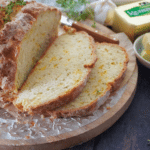Ingredients
- 3 ¾ cups (450g) all-purpose (plain) flour
- 1 ½ teaspoons salt
- 1 ½ level teaspoons baking soda (bicarbonate of soda) (see note 1)
- ¾ cup (75g) shredded or grated cheese (I used cheddar)
- 2 cloves garlic, crushed
- 1 teaspoon dried mixed herbs (Use any herb or mix like thyme, rosemary or oregano, )
- 2 cups (480ml) buttermilk (see note 2)
Instructions
- Line your baking pan with parchment paper (baking paper) - see note 3 for baking pan options
- Preheat the Oven: Place the oven rack in the middle and preheat to 356°F (180°C) or 160°C for fan ovens.
- In a large bowl, combine the all purpose flour, salt, baking soda, shredded cheese, dried herbs, and crushed garlic.
- Pour in the buttermilk and mix gently with a wooden spoon or your hands until the dough forms a ball.
- Shape the Dough: Transfer the dough to a floured surface and pat it into a round shape about 6 inches (15 cm) in diameter and 1 ½ inches (4 cm) thick. It's okay if the dough feels a bit sticky (see note 4).
- Prepare for Baking: Place the dough in your prepared baking pan.Use a sharp serrated knife to cut a large X on the top of the dough.
- Bake: Bake for 40–45 minutes, or until the bottom sounds hollow when tapped. If the top browns too quickly, loosely cover it with aluminum foil.
- Cool and Slice: Let the bread cool on a rack for at least 30 minutes before slicing.
Recipe Notes
1) Baking Soda Freshness: Baking soda is crucial in this recipe to help the bread rise since there's no yeast.
2) Buttermilk: Buttermilk is important in Irish soda bread because it reacts with baking soda, helping the bread rise and keeping it soft. If you don’t have buttermilk, here’s an easy substitute:
3) Baking Pan Options: Here are some options for pans you can use to bake your bread:
4) Keep in Mind That a Slightly Sticky Dough is Perfectly Normal: This is actually a good sign when making Irish soda bread. Here’s why:
Scroll Up for the STEP by STEP Photos! Don't miss the process shots in the post above. Simply scroll up the post to find them. Those were created especially for you so that you can make the recipe perfectly every single time you try it.
- Always use level teaspoons of baking soda to ensure the right amount—too much can give the bread a bitter taste, and too little will affect its rise.
- If you'd like to test its freshness, mix about 1 teaspoon of baking soda with a few drops of vinegar. It should fizz vigorously—if not, it’s time for a new box.
- Do not use baking powder as it won't work the same way in this recipe.
2) Buttermilk: Buttermilk is important in Irish soda bread because it reacts with baking soda, helping the bread rise and keeping it soft. If you don’t have buttermilk, here’s an easy substitute:
- For 2 cups (500ml) of buttermilk: Mix 2 tablespoons of vinegar or lemon juice with about 1 ¾ cups (420ml) of cold milk. Let it sit for 5 minutes to thicken.
- Using less milk in the substitute helps maintain the right dough consistency, otherwise, the dough will be too sticky. Whether using buttermilk or this substitute, make sure it’s cold for the best results.
3) Baking Pan Options: Here are some options for pans you can use to bake your bread:
- Shape the dough and place it on a lined large baking sheet.
- Use a 9-inch (23cm) cast iron skillet (pan).
- Or opt for a greased and lined 8-inch (20cm) cake pan.
4) Keep in Mind That a Slightly Sticky Dough is Perfectly Normal: This is actually a good sign when making Irish soda bread. Here’s why:
- Tender Texture: A bit of stickiness means you haven’t overmixed the dough, which helps keep the bread tender and light.
- Moisture: The moisture in a slightly sticky dough contributes to a softer crumb in the finished bread.
- Flour Adjustment: If the dough is too sticky to handle, you can sprinkle a little extra flour on your work surface and your hands, but be careful not to add too much. Just ensure it's manageable. Over-flouring can make the bread dense.
Scroll Up for the STEP by STEP Photos! Don't miss the process shots in the post above. Simply scroll up the post to find them. Those were created especially for you so that you can make the recipe perfectly every single time you try it.
Nutrition
Serving: 1serving | Calories: 197kcal | Carbohydrates: 32g | Protein: 7g | Fat: 4g | Saturated Fat: 2g | Polyunsaturated Fat: 0.3g | Monounsaturated Fat: 1g | Cholesterol: 11mg | Sodium: 414mg | Potassium: 103mg | Fiber: 1g | Sugar: 2g | Calcium: 103mg | Iron: 2mg
